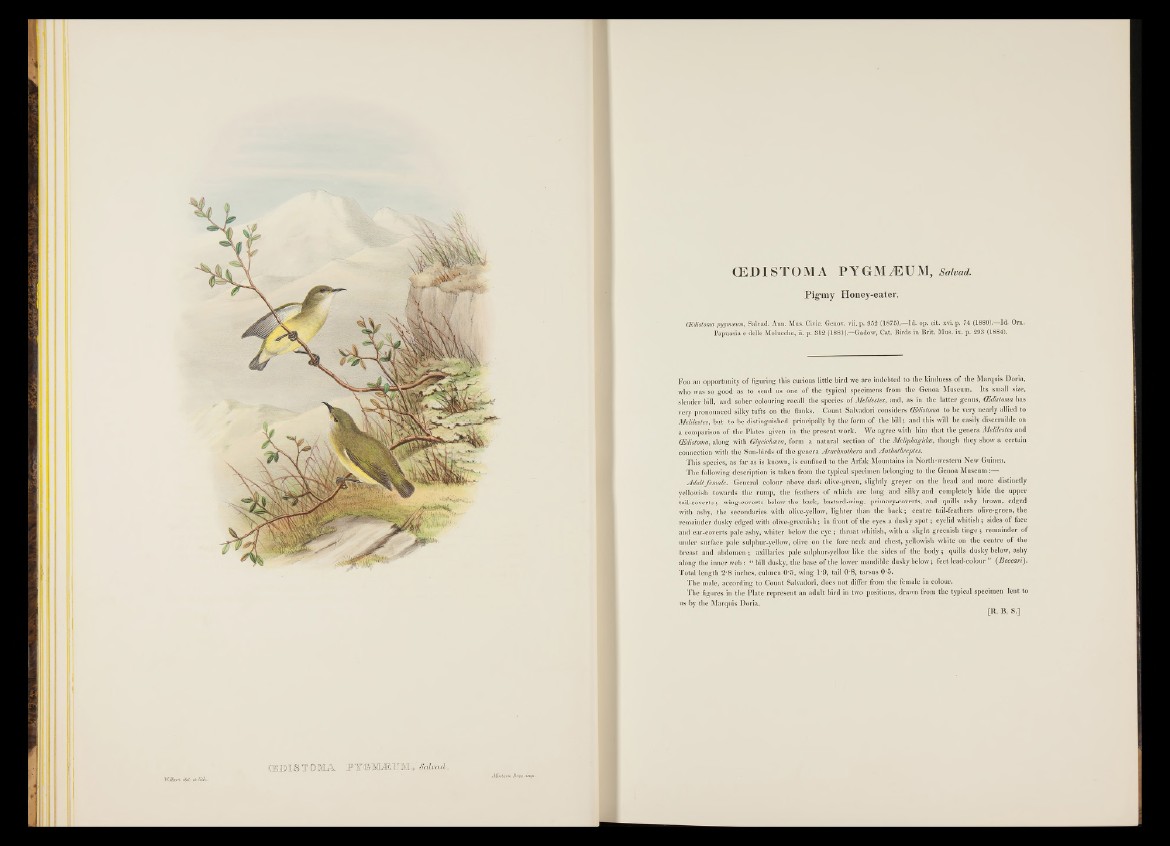
W.thrb d e l et- Ut/v.
IOEBIB TOSÍA. PTeMÆUMU ’ W«</
Mintemi Bros, imp ■
OEDISTOMA PYGMÆUM, Salvad.
Pigmy Honey-eater.
(Edistoma pygmceum, Salvad. Ann. Mus. Civic. Genov, vii. p. 952 (1875).—Id. op. cit. xvi. p. 74 (1880).—Id. Orn.
Papuasia e delle Molucche, ii. p. 312 (1881).—Gadow, Cat. Birds in Brit. Mus. ix. p. 293 (1884).
F or an opportunity o f figuring this curious little bird we are indebted to the kindness o f the Marquis Doria,
who was so good as to send us one o f the typical specimens from the Genoa Museum. I ts small size,
slender bill, and sober colouring recall the species o f Melilestes, and, as in the latter genus, (Edxstoma has
very pronounced silky tufts on the flanks. Count Salvadori considers (Edistoma to be very nearly allied to
Melilestes, but to be distinguished principally by the form o f the bill; and this will be easily discernible on
a comparison of the Plates given in the present work. We agree with him th at the genera Melilestes and
(Edistoma, along with Glycichara, form a natural section o f the Meliphagidce, though they show a certain
connection with the Sun-birds o f the genera Arachnothera and Anthothreptes.
This species, as far as is known, is confined to the Arfak Mountains in North-western New Guinea.
The following description is taken from the typical specimen belonging to the Genoa Museum
Adult female. General colour above dark olive-green, slightly greyer on the head and more distinctly
yellowish towards the rump, the feathers o f which are long and silky and completely hide the upper
tail-coverts; wing-coverts below the back, bastard-wing, primary-coverts, and quills ashy brown, edged
with ashy, the secondaries with olive-yellow, lighter than the h a ck ; centre tail-feathers olive-green, the
remainder dusky edged with olive-greenish; in front o f the eyes a dusky s p o t; eyelid whitish; sides o f face
and ear-coverts pale ashy, whiter below the e y e ; throat whitish, with a slight greenish tinge ; remainder of
under surface pale sulphur-yellow, olive on the fore neck and chest, yellowish white on the centre o f the
breast and abdomen ; axillaries pale sulphur-yellow like the sides of the b ody; quills dusky below, ashy
along the inner w e b : “ bill dusky, the base o f the lower mandible dusky below; feet lead-colour ” ( Beccari).
Total length 2*8 inches, culmen 0 '5 , wing 1*9, tail 0 -8, tarsus 0 ’5.
T h e male, according to Count Salvadori, does not differ from the female in colour.
The figures in the Plate represent an adult bird in two positions, drawn from the typical specimen lent to
us by the Marquis Doria.
[R. B. S.]